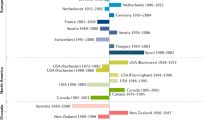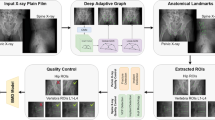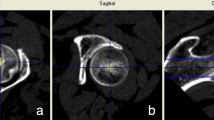Abstract
Methods for identifying patients at high risk for osteoporotic fractures, including dual-energy X-ray absorptiometry (DXA)1,2 and risk predictors like the Fracture Risk Assessment Tool (FRAX)3,4,5,6, are underutilized. We assessed the feasibility of automatic, opportunistic fracture risk evaluation based on routine abdomen or chest computed tomography (CT) scans. A CT-based predictor was created using three automatically generated bone imaging biomarkers (vertebral compression fractures (VCFs), simulated DXA T-scores and lumbar trabecular density) and CT metadata of age and sex. A cohort of 48,227 individuals (51.8% women) aged 50–90 with available CTs before 2012 (index date) were assessed for 5-year fracture risk using FRAX with no bone mineral density (BMD) input (FRAXnb) and the CT-based predictor. Predictions were compared to outcomes of major osteoporotic fractures and hip fractures during 2012–2017 (follow-up period). Compared with FRAXnb, the major osteoporotic fracture CT-based predictor presented better receiver operating characteristic area under curve (AUC), sensitivity and positive predictive value (PPV) (+1.9%, +2.4% and +0.7%, respectively). The AUC, sensitivity and PPV measures of the hip fracture CT-based predictor were noninferior to FRAXnb at a noninferiority margin of 1%. When FRAXnb inputs are not available, the initial evaluation of fracture risk can be done completely automatically based on a single abdomen or chest CT, which is often available for screening candidates7,8.
This is a preview of subscription content, access via your institution
Access options
Access Nature and 54 other Nature Portfolio journals
Get Nature+, our best-value online-access subscription
$29.99 / 30 days
cancel any time
Subscribe to this journal
Receive 12 print issues and online access
$209.00 per year
only $17.42 per issue
Buy this article
- Purchase on Springer Link
- Instant access to full article PDF
Prices may be subject to local taxes which are calculated during checkout



Similar content being viewed by others
Data availability
The study protocol can be shared upon request. Access to the data used for this study can be made available upon request, subject to an internal review by N.D. and R.D.B. to ensure that participant privacy is protected, and subject to completion of a data sharing agreement, approval from the institutional review board of Clalit Health Services and institutional guidelines and in accordance with the current data sharing guidelines of Clalit Health Services and Israeli law. Pending the aforementioned approvals, data sharing will be made in a secure setting, on a per-case-specific manner from the chief information security officer of Clalit Health Services. Please submit such requests to N.D. (noada@clalit.org.il).
Code availability
Requests for the statistical code will be considered by the authors according to the stated need and dependent on specific approval by the information security office of Clalit Health Services.
References
Curtis, J. R. et al. Longitudinal trends in use of bone mass measurement among older Americans, 1999–2005. J. Bone Miner. Res. 23, 1061–1067 (2008).
Medical Advisory Secretariat. Utilization of DXA bone mineral densitometry in Ontario: an evidence-based analysis. Ont. Health Technol. Assess. Ser. 6, 1–180 (2006).
Kanis, J. A., Johnell, O., Oden, A., Johansson, H. & McCloskey, E. FRAX and the assessment of fracture probability in men and women from the UK. Osteoporos. Int. 19, 385–397 (2008).
Marques, A. et al. The accuracy of osteoporotic fracture risk prediction tools: a systematic review and meta-analysis. Ann. Rheum. Dis. 74, 1958–1967 (2015).
Viswanathan, M. et al. Screening to prevent osteoporotic fractures: updated evidence report and systematic review for the US Preventive Services Task Force. JAMA 319, 2532–2551 (2018).
Beaudoin, C. et al. Performance of predictive tools to identify individuals at risk of non-traumatic fracture: a systematic review, meta-analysis, and meta-regression. Osteoporos. Int. 30, 721–740 (2019).
Hess, E. P. et al. Trends in computed tomography utilization rates: a longitudinal practice-based study. J. Patient Saf. 10, 52–58 (2014).
Levin, D. C., Rao, V. M. & Parker, L. Financial impact of Medicare code bundling of CT of the abdomen and pelvis. AJR Am. J. Roentgenol. 202, 1069–1071 (2014).
Brauer, C. A., Coca-Perraillon, M., Cutler, D. M. & Rosen, A. B. Incidence and mortality of hip fractures in the United States. JAMA 302, 1573–1579 (2009).
Dyer, S. M. et al. A critical review of the long-term disability outcomes following hip fracture. BMC Geriatr. 16, 158 (2016).
National Institute for Health and Care Excellence. Alendronate, Etidronate, Risedronate, Raloxifene and Strontium Ranelate for the Primary Prevention of Osteoporotic Fragility Fractures in Postmenopausal Women (NICE, 2008); https://www.nice.org.uk/guidance/ta160/resources/raloxifene-for-the-primary-prevention-of-osteoporotic-fragility-fractures-in-postmenopausal-women-pdf-82598368491205
Huntjens, K. M. et al. Fracture liaison service: impact on subsequent nonvertebral fracture incidence and mortality. J. Bone Joint Surg. Am. 96, e29 (2014).
Cosman, F. et al. Clinician’s guide to prevention and treatment of osteoporosis. Osteoporos. Int. 25, 2359–2381 (2014).
Korthoewer, D. & Chandran, M. Osteoporosis management and the utilization of FRAX®: a survey amongst health care professionals of the Asia-Pacific. Arch. Osteoporos. 7, 193–200 (2012).
Silverman, S. L. & Calderon, A. D. The utility and limitations of FRAX: a US perspective. Curr. Osteoporos. Rep. 8, 192–197 (2010).
Lewiecki, E. M. Managing osteoporosis: challenges and strategies. Cleve. Clin. J. Med. 76, 457–466 (2009).
Compston, J. et al. UK clinical guideline for the prevention and treatment of osteoporosis. Arch. Osteoporos. 12, 43 (2017).
Cebul, R. D., Rebitzer, J. B., Taylor, L. J. & Votruba, M. E. Organizational fragmentation and care quality in the US healthcare system. J. Econ. Perspect. 22, 93–113 (2008).
Karr, A. F. et al. Comparing record linkage software programs and algorithms using real-world data. PLoS ONE 14, e0221459 (2019).
Herring, B. Suboptimal provision of preventive healthcare due to expected enrollee turnover among private insurers. Health Econ. 19, 438–448 (2010).
Lee, S., Chung, C. K., Oh, S. H. & Park, S. B. Correlation between bone mineral density measured by dual-energy X-ray absorptiometry and Hounsfield units measured by diagnostic CT in lumbar spine. J. Korean Neurosurg. Soc. 54, 384–389 (2013).
Pickhardt, P. J. et al. Simultaneous screening for osteoporosis at CT colonography: bone mineral density assessment using MDCT attenuation techniques compared with the DXA reference standard. J. Bone Miner. Res. 26, 2194–2203 (2011).
Lee, S. J., Anderson, P. A. & Pickhardt, P. J. Predicting future hip fractures on routine abdominal CT using opportunistic osteoporosis screening measures: a matched case-control study. AJR Am. J. Roentgenol. 209, 395–402 (2017).
Melton, L. J. 3rd, Atkinson, E. J., Cooper, C., O’Fallon, W. M. & Riggs, B. L. Vertebral fractures predict subsequent fractures. Osteoporos. Int. 10, 214–221 (1999).
Summers, R. M. et al. Feasibility of simultaneous computed tomographic colonography and fully automated bone mineral densitometry in a single examination. J. Comput. Assist. Tomogr. 35, 212–216 (2011).
Lee, S. J. et al. Opportunistic screening for osteoporosis using the sagittal reconstruction from routine abdominal CT for combined assessment of vertebral fractures and density. Osteoporos. Int. 27, 1131–1136 (2016).
Steyerberg, E. W. Clinical Prediction Models: a Practical Approach to Development, Validation, and Updating (Springer, 2009).
Fraser, L. A. et al. Fracture prediction and calibration of a Canadian FRAX® tool: a population-based report from CaMos. Osteoporos. Int. 22, 829–837 (2011).
Pressman, A. R., Lo, J. C., Chandra, M. & Ettinger, B. Methods for assessing fracture risk prediction models: experience with FRAX in a large integrated health care delivery system. J. Clin. Densitom. 14, 407–415 (2011).
Dagan, N., Cohen-Stavi, C., Leventer-Roberts, M. & Balicer, R. D. External validation and comparison of three prediction tools for risk of osteoporotic fractures using data from population based electronic health records: retrospective cohort study. BMJ 356, i6755 (2017).
Pickhardt, P. J., Bodeen, G., Brett, A., Brown, J. K. & Binkley, N. Comparison of femoral neck BMD evaluation obtained using Lunar DXA and QCT with asynchronous calibration from CT colonography. J. Clin. Densitom. 18, 5–12 (2015).
Ziemlewicz, T. J. et al. Opportunistic quantitative CT bone mineral density measurement at the proximal femur using routine contrast-enhanced scans: direct comparison with DXA in 355 adults. J. Bone Miner. Res. 31, 1835–1840 (2016).
Pickhardt, P. J. et al. Population-based opportunistic osteoporosis screening: validation of a fully automated CT tool for assessing longitudinal BMD changes. Br. J. Radiol. 92, 20180726 (2019).
Jang, S. et al. Opportunistic osteoporosis screening at routine abdominal and thoracic CT: normative L1 trabecular attenuation values in more than 20,000 adults. Radiology 291, 360–367 (2019).
Pickhardt, P. J. et al. Opportunistic screening for osteoporosis using abdominal computed tomography scans obtained for other indications. Ann. Intern. Med. 158, 588–595 (2013).
Adams, A. L. et al. Osteoporosis and hip fracture risk from routine computed tomography scans: the Fracture, Osteoporosis, and CT Utilization Study (FOCUS). J. Bone Miner. Res. 33, 1291–1301 (2018).
Sirota-Cohen, C., Rosipko, B., Forsberg, D. & Sunshine, J. L. Implementation and benefits of a vendor-neutral archive and enterprise-imaging management system in an integrated delivery network. J. Digit. Imaging 32, 211–220 (2019).
Nagels, J., Macdonald, D. & Coz, C. Measuring the benefits of a regional imaging environment. J. Digit. Imaging 30, 609–614 (2017).
Burge, R. et al. Incidence and economic burden of osteoporosis-related fractures in the United States, 2005–2025. J. Bone Miner. Res. 22, 465–475 (2007).
Hernlund, E. et al. Osteoporosis in the European Union: medical management, epidemiology and economic burden. A report prepared in collaboration with the International Osteoporosis Foundation (IOF) and the European Federation of Pharmaceutical Industry Associations (EFPIA). Arch. Osteoporos. 8, 136 (2013).
Gross, R., Rosen, B. & Chinitz, D. Evaluating the Israeli health care reform: strategy, challenges and lessons. Health Policy 45, 99–117 (1998).
Bar, A., Wolf, L., Bergman Amitai, O., Toledano, E. & Elnekave, E. Compression fractures detection on CT. In Proc. SPIE 10134, Medical Imaging 2017: Computer-Aided Diagnosis (eds Armato, S.G. 3rd & Petrick, N. A.) 1013440 (SPIE, 2017).
Krishnaraj, A. et al. Simulating dual-energy X-ray absorptiometry in CT using deep-learning segmentation cascade. J. Am. Coll. Radiol. 16, 1473–1479 (2019).
Bregman-Armitai, O. & Elnekave, E. Systems and methods for emulating DEXA scores based on CT images. Patent no. WO2016013005A2 (2019); https://patentimages.storage.googleapis.com/aa/dd/d7/a9ac0a3b551f72/WO2016013005A2.pdf
van Buuren, S. & Groothuis-Oudshoorn, K. MICE: Multivariate imputation by chained equations. R package version 2.22 https://cloud.r-project.org/web/packages/mice/index.html (2014).
Genant, H. K., Wu, C. Y., van Kuijk, C. & Nevitt, M. C. Vertebral fracture assessment using a semiquantitative technique. J. Bone Miner. Res. 8, 1137–1148 (1993).
Ronneberger, O., Fischer, P. & Brox, T. U-Net: Convolutional networks for biomedical image segmentation. In International Conference on Medical Image Computing and Computer-assisted Intervention (Springer, Cham.) 234–241 (2015).
Pickhardt, P. J. et al. Effect of IV contrast on lumbar trabecular attenuation at routine abdominal CT: correlation with DXA and implications for opportunistic osteoporosis screening. Osteoporos. Int. 27, 147–152 (2016).
Marshall, A., Altman, D. G., Holder, R. L. & Royston, P. Combining estimates of interest in prognostic modelling studies after multiple imputation: current practice and guidelines. BMC Med. Res. Methodol. 9, 57 (2009).
Harrell, F. E. Jr. rms: Regression modeling strategies. R package version 4.4-0 https://rdrr.io/cran/rms/ (2015).
Walker, E. & Nowacki, A. S. Understanding equivalence and noninferiority testing. J. Gen. Intern. Med. 26, 192–196 (2011).
Sing, T., Sander, O., Beerenwinkel, N. & Lengauer, T. ROCR: Visualizing the performance of scoring classifiers. R package version 1.0-7 https://rdrr.io/cran/ROCR/ (2015).
Acknowledgements
We thank S. Krispin for her assistance in editing and reviewing the manuscript. This study was supported by a grant given to Clalit Health Services and Zebra Medical Vision by the Israel Innovation Authority (Ministry of Social Equality), to promote digitalized transformation in health care (grant number 64727). The Israel Innovation Authority did not have any active involvement in the study process.
Author information
Authors and Affiliations
Contributions
N.D., N.B., E.E., E.B. and R.D.B. conceived and designed the study. N.D. extracted the data and performed all the statistical analysis. N.D. and N.B. interpreted the data. N.D. and E.E. drafted the manuscript. O.B.A., A.B. and M.O. contributed the formation of the image processing algorithms. All authors critically revised the manuscript. R.D.B. and E.B. supervised the study and are the guarantors.
Corresponding author
Ethics declarations
Competing interests
E.B. has no interests to disclose. N.D., N.B. and R.D.B. report having received grants from the Israel Innovation Authority during the conduct of this study. The parent company of Clalit Research Institute (N.D., N.B. and R.D.B.) owns a minority share in Zebra Medical Vision. E.E., O.B.A., A.B. and M.O. report personal fees from Zebra Medical Vision during the conduct of this study. In addition, E.E. and O.B.A. have a patent for emulating DXA scores based on CT images (WO2016013005A3) and a patent to predict osteoporotic fracture risk (WO2016013004A1).
Additional information
Peer review information Jennifer Sargent was the primary editor on this article and managed its editorial process and peer review in collaboration with the rest of the editorial team.
Publisher’s note Springer Nature remains neutral with regard to jurisdictional claims in published maps and institutional affiliations.
Supplementary information
Supplementary Information
Supplementary Tables 1–7
Rights and permissions
About this article
Cite this article
Dagan, N., Elnekave, E., Barda, N. et al. Automated opportunistic osteoporotic fracture risk assessment using computed tomography scans to aid in FRAX underutilization. Nat Med 26, 77–82 (2020). https://doi.org/10.1038/s41591-019-0720-z
Received:
Accepted:
Published:
Issue Date:
DOI: https://doi.org/10.1038/s41591-019-0720-z
This article is cited by
-
Artificial Intelligence-enabled Chest X-ray Classifies Osteoporosis and Identifies Mortality Risk
Journal of Medical Systems (2024)
-
CT image-based biomarkers for opportunistic screening of osteoporotic fractures: a systematic review and meta-analysis
Osteoporosis International (2024)
-
Establish and validate the reliability of predictive models in bone mineral density by deep learning as examination tool for women
Osteoporosis International (2024)
-
External validation of a convolutional neural network algorithm for opportunistically detecting vertebral fractures in routine CT scans
Osteoporosis International (2024)
-
Screening for the primary prevention of fragility fractures among adults aged 40 years and older in primary care: systematic reviews of the effects and acceptability of screening and treatment, and the accuracy of risk prediction tools
Systematic Reviews (2023)



